To ensure that our basil plants are healthy this season, let’s learn how to identify aphids before they do a ton of harm and use aphid control measures.
The most frequent pests of basil are Japanese beetles and aphids. Spider mites, white flies, caterpillars, and thrips are some other pests. If you cultivate basil, you can experience an aphid infestation and need to rapidly discover how to get rid of aphids from basil.
Many people don’t associate pest control with the developing process of a garden, despite the fact that it might be challenging to manage. Growing houseplants can be challenging, even if you don’t maintain a veggie garden.
Even though basil is a plant you grow indoors, you could frequently need to control aphids on it.

Contents
- 1 What exactly are aphids?
- 2 Is it safe to eat basil with holes?
- 3 Aphid infestation and damage to the basil plant
- 4 Understanding an aphid Infestation
- 5 How does aphid damage look?
- 6 How do I get rid of aphids on my herbs?
- 6.1 Kill aphids using your hands
- 6.2 Spraying method
- 6.3 Make use of beneficial insects and natural predators
- 6.4 Use diatomaceous earth
- 6.5 Spraying to remove aphids on basil plants
- 6.6 Make use of insecticidal soaps
- 6.7 Apply commercial pesticides
- 6.8 Install a greenhouse
- 6.9 Trim the basil plant
- 6.10 Use neem oil
- 6.11 Eliminate ant colonies
- 6.12 Using onions and garlic
- 6.13 Essential oils mixture
- 7 Will vinegar kill aphids on basil?
- 8 The most effective methods to prevent aphids on basil leaves
- 9 Conclusion
What exactly are aphids?
Aphids are tiny insects that consume plant sap. Other plants that they can be spotted on include peppers, tomatoes, and other herbs. Even sunflowers are not exempted.
Most of the time, they can produce a new generation in approximately a month, and also some aphid species have the ability to reproduce asexually.
Additionally, their eggs may endure the winter and sprout in the spring, based on where you reside.
It’s critical to control aphids as soon as you realize you have an issue, so they don’t spread and do further harm.

Is it safe to eat basil with holes?
Most of the time, sure.
Yes, as long as you wash it thoroughly and don’t notice any pests on it. Don’t eat basil if it appears to be horribly rotting, moldy, or ill.
When in doubt, discard it!
Otherwise, as long as you wash the basil thoroughly, you can consume it even if it has holes. Before eating a herb or vegetable, you might want to clean it.
In order to eliminate any bacteria that may still be on the herb, it is probably preferable to pair it with a meal that will be cooked. But if you want to consume it raw, simply wash it thoroughly.
There is no appropriate response to this. It entirely depends on the circumstances, the plant, and the specific pests you’re dealing with!
However, if you wash your basil properly, you should generally be able to eat it even if it has holes. Additionally, make sure there are no other bugs.
Aphid infestation and damage to the basil plant
Aphids are undesirable because they can cause two problems for your plants:
- They are capable of spreading many plant diseases from one plant to the other.
- They prey on plant sap, which can cause plants to become so stressed that growth is slowed.
Also, their suckers can turn the basil plants black, brown, or yellow by sucking the sap. Likewise, they can also spread viruses that affect plants, such as basil mosaics and fusarium wilt.
Understanding an aphid Infestation
Knowing whether you’re dealing with an aphid problem or even if your basil plants are afflicted by one of the typical garden pests is crucial. Typically, aphids are tiny insects, approximately the size of a pinhead.
They are first discovered on the underparts of a plant’s leaves and live in colonies. They are either brilliant red or pale green. The succulent portion of a plant is sucked dry and rendered dead by aphids.
They also leave behind honeydew-like residue in their wake. This route is both perilous and an obvious giveaway. Trails of honeydew are frequently the source of a sooty mold infestation, which puts the plant at even more risk.
Trim off the affected leaves if you observe extensive necrotic or infected areas, or plant tissue death.

How does aphid damage look?
Aphid damage is easily and readily discernible. Keep an eye out for the following: Poorly shaped, curled, or colored basil leaves. Sticky material on the stem of the basil. Deformed basil plants are growing. Galls on the leaves or roots. Small insects on the leaf’s opposite side. There are a lot of little insects on the plant stem. Small insects on the plant’s roots.
How do I get rid of aphids on my herbs?
Aphid control is essential once you’ve identified the issue so that they don’t spread and cause more harm.
Let’s speak about how to get rid of and begin controlling aphids in the garden, as they are one of the most common basil pests.
Use the techniques listed below to quickly solve your aphid populations control problems and kill aphids on basil plants, petunias, pepper plants, milkweed, and other plants where they pose a threat.
Kill aphids using your hands
If you discover an aphid infestation before it becomes too severe, this is the easiest method. It’s better to simply squish and discard the dead aphids when you can only observe a few of them here and there.
If we make the effort of going out in search of remedy treatment at the grocery store plus coming back later on the next day, then we should absolutely consider ourselves fortunate because the colony may have doubled.
This is because these soft-bodied insects and adult aphids procreate really quickly. You may just smash aphids between your hands on the leaves because they won’t bite you.
You can also pluck aphids on basil off, using a damp paper towel, then lightly crush them.
Put the dead aphids inside a trash bag to be disposed of. A re-infestation will result if live aphids are left behind.
To prevent any future aphid problem, clean off any sap or residue from your basil or leaf plants with a moist paper towel.

Spraying method
To protect your plants and save time, it is advisable to start with the simplest solution. If the issue hasn’t already blown out of proportion, using this home cure for controlling aphids on basil or tomato plants will work. Otherwise, it’s a solid beginning.
You can use water, a natural spray, or even something akin to a homemade spider mites spray. Eliminate the aphids on basil leaves by spraying them with a constant stream of water. Utilize a spray bottle that has a strong stream that won’t damage the plants.
After that, wash any affected plants with soapy water prepared from filtered water and insecticidal soap. Dish soap can also be used; however, certain delicate leaves may find it more abrasive.
Afterward, replace any mulch to get rid of aphids that fell to the ground, or scatter diatomaceous earth at the roots of the plants.
Try making your own spray and spray bottle using a homemade aphid killer if this doesn’t work.

Make use of beneficial insects and natural predators
Even though some insects are dangerous, others can really be beneficial. These beneficial insects are introduced and dispersed in the problem area.
They are available online and at some garden supply stores.
Natural predators include lady bugs, parasitic wasps, and lacewings.
The finest aphid predators for eating and destroying aphid eggs and larvae are lady bugs and lacewings.
The ideal animal to draw is a bird, such as a chickadee, which can consume and eradicate vast quantities of adult aphids.
In addition to being excellent at getting rid of aphids, beneficial insects are crucial for avoiding aphid infestations.
You can also attract lace wigs, chickadees, and lady bugs to deter ant colonies from your plants. Aphids are known to draw ants, who also guard them.
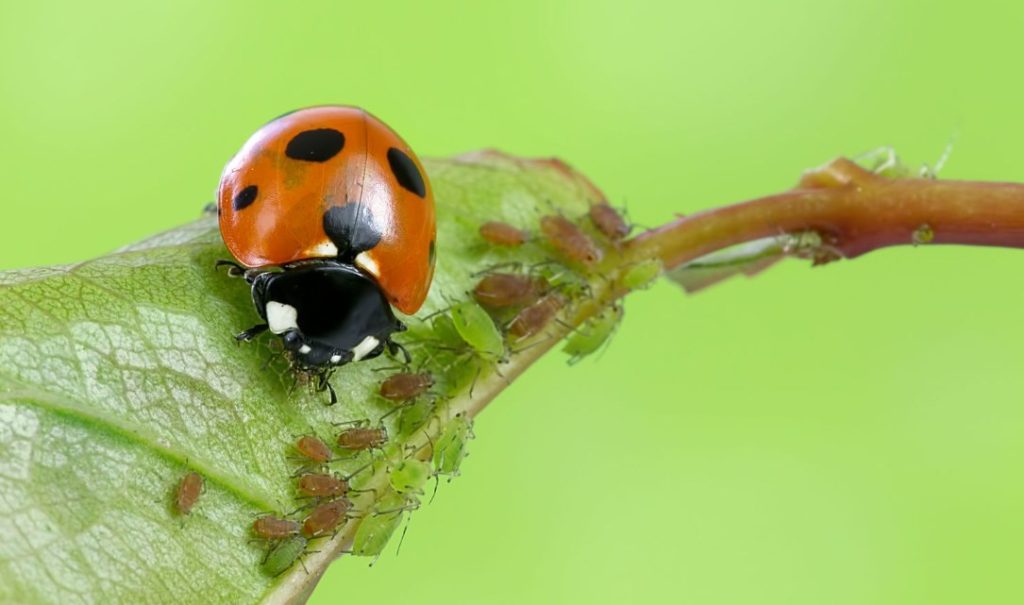
Use diatomaceous earth
Cover the bases of the diseased plants with diatomaceous earth. Wet the entire plant, then evenly distribute it across its surface.
When the aphids move, this material rips at them, instantly killing them.
Additionally, baking soda can be used to get rid of aphids on garden plants like basil. Use it similarly to how you would diatomaceous earth.
Spraying to remove aphids on basil plants
You’ll want to employ more drastic remedies as the infestation becomes more serious. Fortunately, you may use a vigorous water flow from a hose or a spray bottle to wash them off the plant.
You can dip a basil leaf in a jar containing room-temperature water to kill aphid populations if the plant is immature and has delicate leaves that can’t withstand a powerful spray.
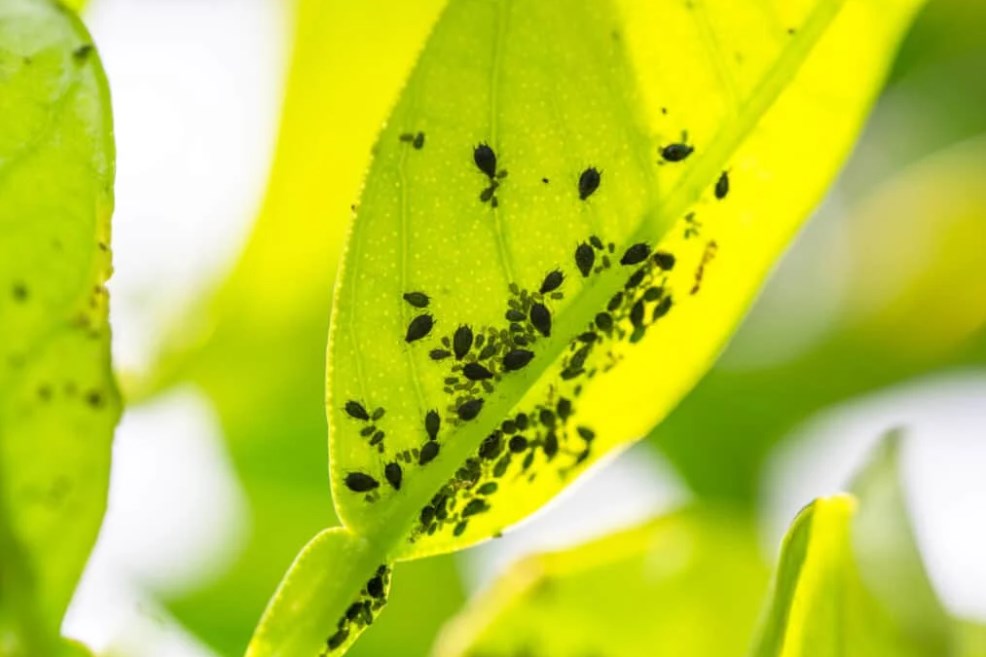
Make use of insecticidal soaps
If you notice numerous aphids on basil, use an established method to manage aphids, like insecticidal soap.
Gardeners and farmers have long employed insecticidal soaps. Without damaging your plants, pets, or people, it may effectively eradicate enormous numbers of soft-shelled insects like aphids.
A cup of oil and one tablespoon of dish soap can also be used to create your own insecticidal soap. Avoid using bleach.
Spray the plants with a solution made of a half gallon of water, one teaspoon of dish soap, and one teaspoon of oil. Start by spraying the bottom side of the basil leaves, where the majority of aphids can be found.
The soapy water will suffocate and get rid of the aphids. Use a dish soap that doesn’t have a lot of potentially dangerous chemicals in it.
Choose the purest form of dish soap because some of them have ingredients that harm plants.
Apply commercial pesticides
If aphids simply refuse to die, then early in the morning, apply a systemic insecticide to your basil plant that has the ingredient imidacloprid.
It is one of the commercial chemicals that are poisonous to destructive insects like aphids, but harmless to people and helpful pollinators.
Apply your pesticide once more until all the aphids have died. It should be remembered that it could take as long as two weeks to completely eradicate and stop the spread of an aphid infestation.
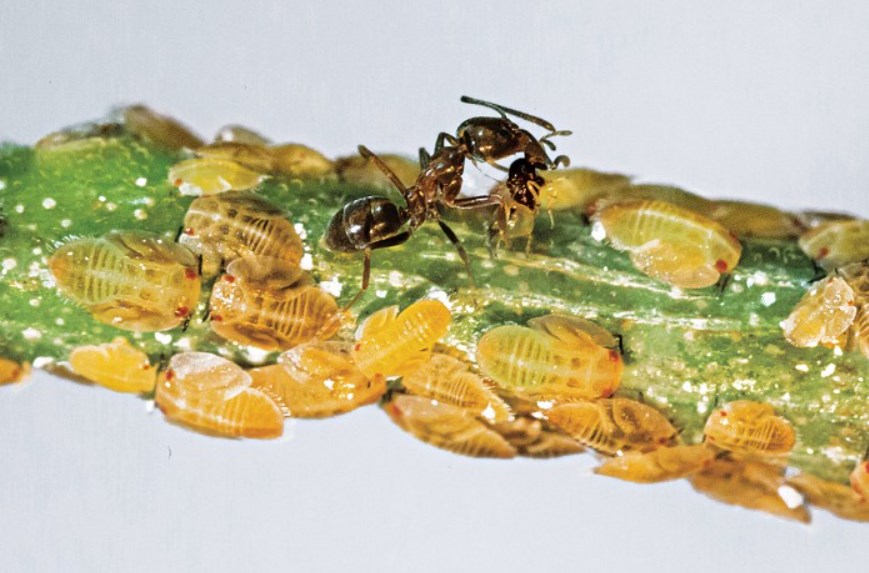
Install a greenhouse
If you don’t have the money or space for a genuine greenhouse, you can get a miniature one.
Set your basil plants inside the greenhouse when it has been set up. When that happens, you can purchase parasitic wasps eggs, lady bugs eggs, or other bugs that repel aphids.
The larvae will emerge from the eggs and remain restricted to the greenhouse, where they will consume aphids all day.
You can free the plant from the confinement of the greenhouse once the aphids have been eliminated.
Trim the basil plant
It is advised to start by removing the leaves. Just one day. Cut a few branches from your basil plant if aphids are still present. Your plant will die if more than one-third of its branches are removed.
Put your diseased branches or leaves in the trash. Never compost them or leave them where aphids can spread to other plants.
Use neem oil
Neem oil is among the preferred aphid control techniques because it effectively kills a variety of insects, including aphids and spider mites.
It is organic and derived from the neem tree, and it has been approved for use in herbs and vegetables.
The damage that aphids can cause can be effectively stopped with pure neem oil. Your plants have plenty of time to recuperate because it takes away their capacity to eat and ultimately kills them.
Although pre-mixed neem oil is available for purchase, homemade preparations have shown to be far more powerful and beneficial.
Neem oil should ideally be applied early in the day or late at night because the sun’s heat combined with it can cause the leaves to burn.
Neem oil has no negative effects on birds or other helpful insects.
Eliminate ant colonies
You will typically find ant colonies where your basil plants have aphid infestations. Ants can be found near aphids because they consume the honeydew that aphids create as waste.
Ants then defend aphids from helpful insects like ladybugs, which can result in infestations growing larger and faster.
And don’t forget to clean the basil plant of the aphids that were there. Remaining honeydew from deceased ants and aphids can still draw in more ants.
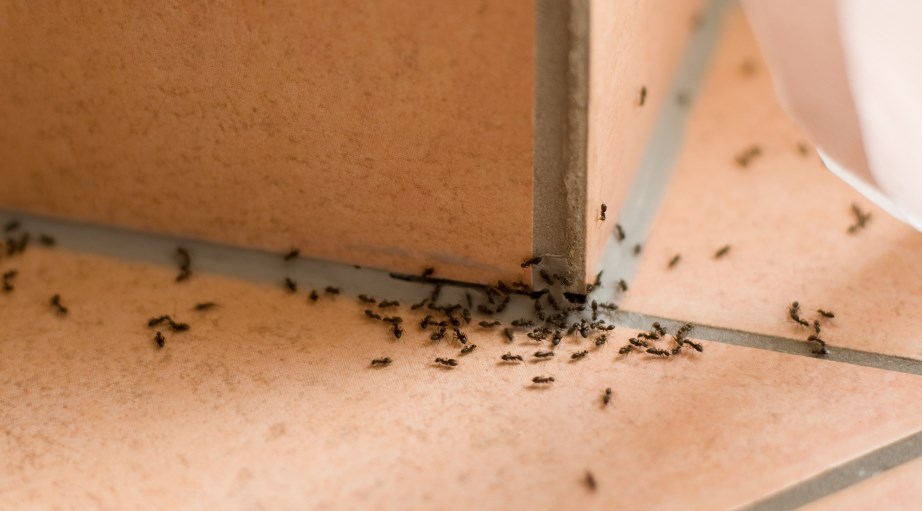
Using onions and garlic
Making a powerful, natural homemade extract is another really effective method of combating pests that cause damage, like aphids.
This vegetable is the ideal treatment for this simple natural cure, and it can easily be found in your kitchen.
As they are particularly good at killing aphids present in your garden and fungal plant diseases, onions and garlic are a great way to deal with pest infestations.
Two cups of boiling water, two cups of garlic, a spoonful of dish soap, and one spoonful of spicy pepper. Pour the mixture into a spray bottle and let it set for the night.
The best thing about these natural mixes is that they don’t harm plants or insects; instead, they simply make the leaves smell bad enough to be repulsive.
Essential oils mixture
It has been demonstrated that certain essential oil mixes are useful in the battle against aphids, but it’s vital to understand the essential oils which are ideal.
The peppermint, rosemary, clove, lavender, and oregano essential oils are the most potent. Dilute the oils with soap or water to make sure you’re only killing pests and not your plants.
Will vinegar kill aphids on basil?
Yes. Due to its tremendous efficacy, vinegar is the most popular method that gardeners use in controlling aphids.
Spray the entire leaf with vinegar after adding it to a spray bottle. Spray the entire leaf, including the underside, where aphids may be lurking.
You will reach the ideal acidity level once you have made the vinegar and water solution.
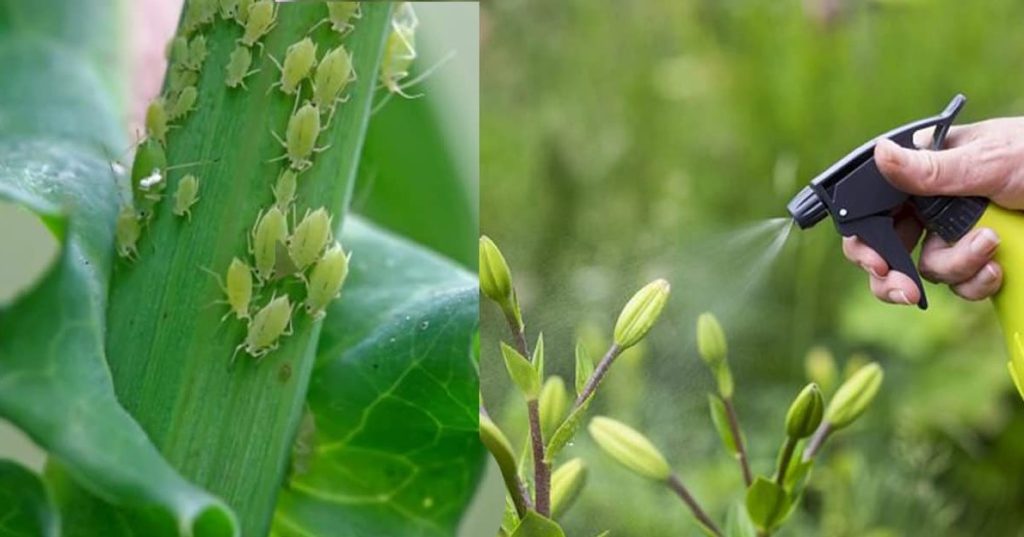
The most effective methods to prevent aphids on basil leaves
Frequently, you wonder where aphids come from when you encounter them on your indoor plants. They originate from a wide range of places, to answer your query.
When windows are open, aphids can pass through the screens. They can also get inside through fresh houseplants you bought, as well as through food you brought indoors from the garden or fresh flowers.
Understanding their origins aids in preventing their recurrence. You would be completely mistaken to believe that a basil plant indoors would be immune to pests of this nature.
Always isolate new houseplants for a few days prior to putting them close to the others after purchasing them.
If bugs are found, treat the entire plant and isolate it until all pests have disappeared.
Choose the appropriate companion plants
Planting the following things near basil plants will enhance the likelihood that aphids won’t attack your basil plants because they have potent fragrances that insects detest: Oregano, chives, garlic, onions, and basil.
These are excellent plants to use in gardens to ward off pests like chipmunks, squirrels, and deer. When grown next to lettuce, peas, and rose plants, garlic and chives repel aphids.
To avoid basil infestation, you can also establish plants that draw aphids to a different location in your garden or yard. These include asters, cosmos, dahlias, and zinnias.
Do not overfertilize
Faster new growth is encouraged by fertilization. The majority of the time, new basil plant development attracts aphids.
Applying lesser amounts of fertilizer throughout the course of the year is preferable to fertilize your basil plants in one go. A slow-release product can also be used to apply fertilizer once.
Water basil plants regularly
Water your basil plants regularly all year long. This is particularly crucial during dry or hot summer days.
Lack of water weakens basils, reducing their capacity to produce compounds that can protect them from damaging pests like aphids.
It is advised to water your entire plants at least an extra day every week if you find that aphids return to them year after year.
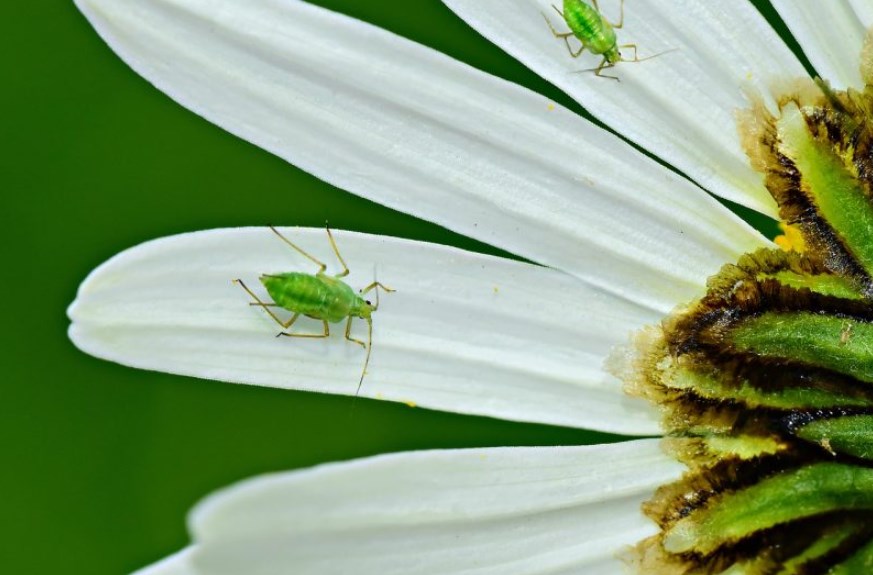
Conclusion
By now, you should feel prepared to handle any aphid problem properly after reading this article or at least feel ready in case one arises.
These treatments will get rid of aphids on basil and other pests from your garden without endangering your plants or people.
As long as you adhere to the directions, you can easily combine these natural treatments using supplies you already have at home.
Read also: How to harvest rosemary without killing the plant: a step-by-step guide

